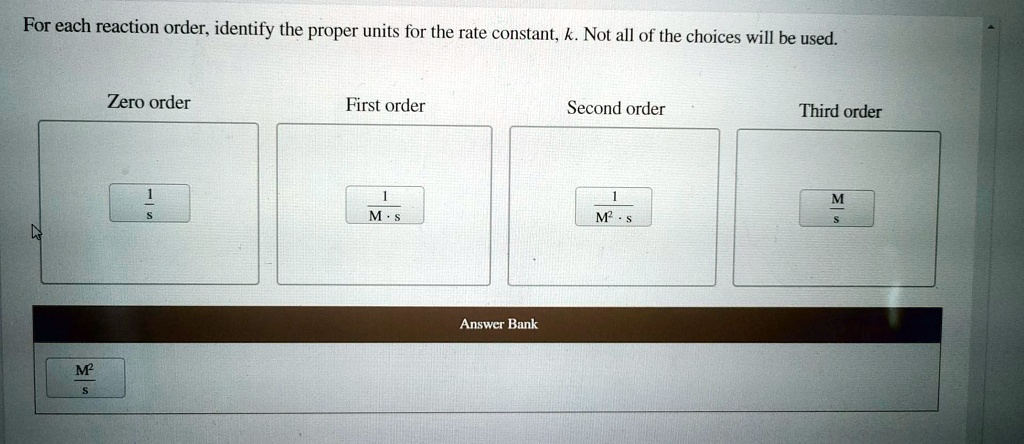For each reaction order: identify the proper units for the rate constant; k. Not all of the choices will be used: Zero order First order Second order Third order M . $ M” Answcr Bank M

The Correct Answer and Explanation is:
Here are the correct units for the rate constant kk for each reaction order:
- Zero order: Not listed in the answer bank
- First order: 1/s
- Second order: 1/(M·s)
- Third order: M²/s
Explanation:
The rate constant kk in a chemical rate law must carry units that balance the equation so that the rate of reaction always has units of concentration over time, typically expressed as M/s (molarity per second).
- Zero-order reactions follow the rate law:
rate=k\text{rate} = k
Since rate has units of M/s, kk must also have units of M/s. However, this unit is not present in the provided answer bank, so we disregard it for this task.
- First-order reactions follow:
rate=k[A]\text{rate} = k[A]
Here,
k=rate[A]k = \frac{\text{rate}}{[A]}
Substituting units:
k=M/sM=1/sk = \frac{\text{M/s}}{\text{M}} = 1/\text{s}
So the proper unit from the answer bank is 1/s.
- Second-order reactions typically follow:
rate=k[A]2ork[A][B]\text{rate} = k[A]^2 \quad \text{or} \quad k[A][B]
Rearranging gives:
k=rate[A]2orM/sM2=1/(M\cdotps)k = \frac{\text{rate}}{[A]^2} \quad \text{or} \quad \frac{\text{M/s}}{\text{M}^2} = 1/(\text{M·s})
So the correct unit from the bank is 1/(M·s).
- Third-order reactions may be written as:
rate=k[A]3ork[A]2[B]ork[A][B][C]\text{rate} = k[A]^3 \quad \text{or} \quad k[A]^2[B] \quad \text{or} \quad k[A][B][C]
In all cases:
k=M/sM3=M−2/sk = \frac{\text{M/s}}{\text{M}^3} = \text{M}^{-2}/\text{s}
This is equivalent to M²/s when rearranged with positive exponents for the given unit style.
These units are essential in determining the rate law from experimental data and in modeling reaction kinetics across various chemical contexts.
